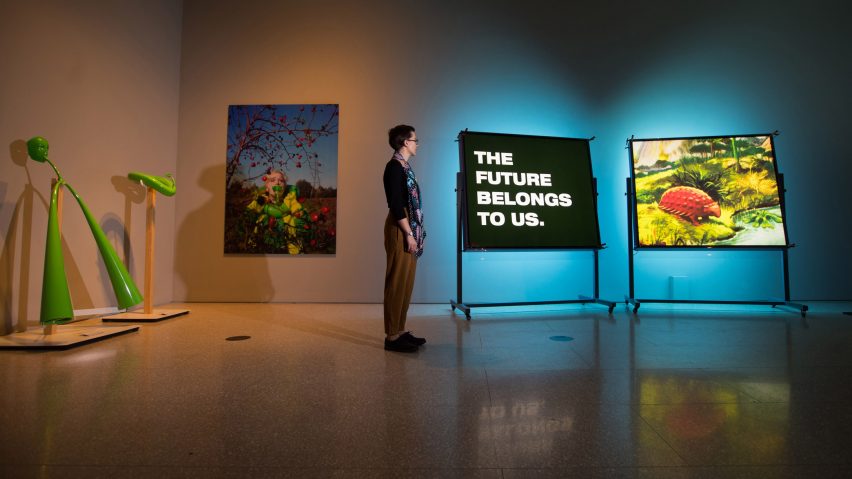Eco-Visionaries at London's Royal Academy of Arts looks at how art and architecture can help us respond to environmental change, and is the latest in a line of recent large-scale exhibitions on the theme.
The show brings together international artists, designers and architects who are confronting environmental issues through their practice, at a critical moment for the planet.
It is the latest exhibition about our fractured relationship with the natural world, following the Broken Nature exhibition at the Milan Triennale, Nature at Cooper Hewitt in New York, Cube in the Netherlands and The Coming World at Garage Museum in Moscow.
"Everyone is taking a different approach and talking about specific issues, but what's important is that we're all doing it at the same time," said architecture programme curator at the RA, Gonzalo Herrero Delicado.
"We're seeing in the papers on a daily basis that we need to take action now, from Extinction Rebellion to Greta Thunberg, they're telling us we need to act now or it's going to be too late," he continued.
"We need to rethink our relationship with nature, and at museums we have a responsibility to make artists and architects' voices heard, not necessarily to a specialist audience."
The issues addressed in the show at the Royal Academy of Arts include species extinction, resource depletion, climate change and the food shortages that will ensue.
Each of the works by 21 creatives from all around the world consider the interaction between humans and nature, and many offer some kind of alternative vision for the future.
Practitioners, including Virgil Abloh, Olafur Eliasson and Rimini Protokoll make use of a wide range of media, including film, immersive installations, sculpture, architectural models and full-scale prototypes.
The exhibition was initiated as a joint curatorial-project between six European museums, with MAAT in Lisbon kicking off with an Eco-Visionaries exhibition last year.
The curators of the MAAT show, Pedro Gadanho and Mariana Pestana, joined Herrero Delicado, to put together the exhibition.
"It's part of our nature at the RA to collaborate," said Herrero Delicado. "We are a private institution and we need to do collaborations to be able to put on more ambitious projects."
Each museum brought its own specific approach to the theme, to create a unique exhibition in each location.
The RA exhibition is the last in the series, which Herrero Delicado said is an advantage as they were able to learn from the other shows how best to communicate the work.
"The collaboration really helped to give shape to the project," explained Herrero Delicado. "In our case though, it was really important to reach a young audience so we chose participants who might be more familiar to teenagers, like Virgil Abloh."
Whilst there is some crossover in the works included, around a third of the exhibits have not previously been seen in other exhibitions at the partner institutions.
Examples include Alexandra Daisy Ginsberg's The Substitute – a five-metre-long screen that recreates the last of the now extinct white rhinos as it "roams" in a digital space, and Virgil Abloh's Alaska Chair.
Some pieces were specially commissioned for the exhibition, such as a film by Nerea Calvillo called by Madrid in the Air, that looks at air pollution in the Spanish capital.
Other projects on display include a research project by Unknown Fields that explores lithium extraction in Bolivia, Olafur Eliasson's The ice melting series from 2002 and architecture studio WORKac's 3.C.City: Climate, Convention, Cruise – a project that conceives a speculative floating city.
The exhibition is designed by Delvendahl Martin Architects with graphic design by Daly & Lyon.
The studios have followed a sustainability strategy, making use of reclaimed materials in the displays and avoiding single-use plastics in order to reduce the exhibition's carbon footprint and minimise the generation of waste.
"Everything you see in the exhibition has been reclaimed," said Herrero Delicado. "We collected dividing walls and boards from previous exhibitions."
All the works were shipped to the exhibition in trucks shared with other institutions, with only one work flying in from New York, in a bid to prove to their colleagues that it is possible to put on an exhibition more sustainably.
"As institutions, we're not fighting any more to see who has more numbers going through the door, we need to really take action," said Herrero Delicado.
"We need to change our priorities, and put nature first, putting the needs of other species ahead of our own."
Eco-Visionaries: Confronting a planet in a state of emergency opens at the RA on 23 November.
Images by David Parry.

